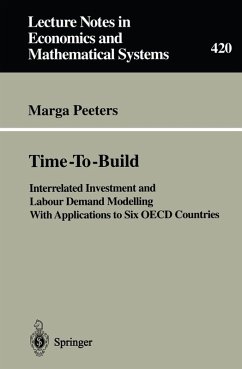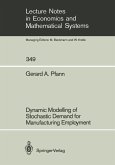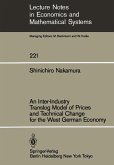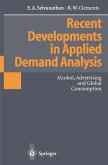Marga Peeters
Time-To-Build (eBook, PDF)
Interrelated Investment and Labour Demand Modelling With Applications to Six OECD Countries
40,95 €
40,95 €
inkl. MwSt.
Sofort per Download lieferbar

20 °P sammeln
40,95 €
Als Download kaufen

40,95 €
inkl. MwSt.
Sofort per Download lieferbar

20 °P sammeln
Jetzt verschenken
Alle Infos zum eBook verschenken
40,95 €
inkl. MwSt.
Sofort per Download lieferbar
Alle Infos zum eBook verschenken

20 °P sammeln
Marga Peeters
Time-To-Build (eBook, PDF)
Interrelated Investment and Labour Demand Modelling With Applications to Six OECD Countries
- Format: PDF
- Merkliste
- Auf die Merkliste
- Bewerten Bewerten
- Teilen
- Produkt teilen
- Produkterinnerung
- Produkterinnerung

Bitte loggen Sie sich zunächst in Ihr Kundenkonto ein oder registrieren Sie sich bei
bücher.de, um das eBook-Abo tolino select nutzen zu können.
Hier können Sie sich einloggen
Hier können Sie sich einloggen
Sie sind bereits eingeloggt. Klicken Sie auf 2. tolino select Abo, um fortzufahren.

Bitte loggen Sie sich zunächst in Ihr Kundenkonto ein oder registrieren Sie sich bei bücher.de, um das eBook-Abo tolino select nutzen zu können.
As large physical capital stock projects need long periods to be built, a time-to-build specification is incorporated in factor demand models. Time-to-build and adjustment costs dynamics are identified since by the first moving average dynamics, whereas by the latter autoregressive dynamics are induced. Empirical evidence for time-to-build is obtained from data from the Dutch construction industry and by the estimation result from the manufacturing industry of six OECD countries.
- Geräte: PC
- ohne Kopierschutz
- eBook Hilfe
- Größe: 17.92MB
Andere Kunden interessierten sich auch für
![Dynamic Modelling of Stochastic Demand for Manufacturing Employment (eBook, PDF) Dynamic Modelling of Stochastic Demand for Manufacturing Employment (eBook, PDF)]() Gerard A. PfannDynamic Modelling of Stochastic Demand for Manufacturing Employment (eBook, PDF)40,95 €
Gerard A. PfannDynamic Modelling of Stochastic Demand for Manufacturing Employment (eBook, PDF)40,95 €![Topics in Structural VAR Econometrics (eBook, PDF) Topics in Structural VAR Econometrics (eBook, PDF)]() Gianni AmisanoTopics in Structural VAR Econometrics (eBook, PDF)73,95 €
Gianni AmisanoTopics in Structural VAR Econometrics (eBook, PDF)73,95 €![An Inter-Industry Translog Model of Prices and Technical Change for the West German Economy (eBook, PDF) An Inter-Industry Translog Model of Prices and Technical Change for the West German Economy (eBook, PDF)]() S. NakamuraAn Inter-Industry Translog Model of Prices and Technical Change for the West German Economy (eBook, PDF)40,95 €
S. NakamuraAn Inter-Industry Translog Model of Prices and Technical Change for the West German Economy (eBook, PDF)40,95 €![Recent Developments in Applied Demand Analysis (eBook, PDF) Recent Developments in Applied Demand Analysis (eBook, PDF)]() E. A. SelvanathanRecent Developments in Applied Demand Analysis (eBook, PDF)40,95 €
E. A. SelvanathanRecent Developments in Applied Demand Analysis (eBook, PDF)40,95 €![Poverty Alleviation in China (eBook, PDF) Poverty Alleviation in China (eBook, PDF)]() Kun YanPoverty Alleviation in China (eBook, PDF)73,95 €
Kun YanPoverty Alleviation in China (eBook, PDF)73,95 €![Wages, Regime Switching, and Cycles (eBook, PDF) Wages, Regime Switching, and Cycles (eBook, PDF)]() Piero FerriWages, Regime Switching, and Cycles (eBook, PDF)73,95 €
Piero FerriWages, Regime Switching, and Cycles (eBook, PDF)73,95 €- -41%11
![Beschäftigungstheorie (eBook, PDF) Beschäftigungstheorie (eBook, PDF)]() Oliver LandmannBeschäftigungstheorie (eBook, PDF)20,67 €
Oliver LandmannBeschäftigungstheorie (eBook, PDF)20,67 € -
- -26%11
- -22%11
As large physical capital stock projects need long periods to be built, a time-to-build specification is incorporated in factor demand models. Time-to-build and adjustment costs dynamics are identified since by the first moving average dynamics, whereas by the latter autoregressive dynamics are induced. Empirical evidence for time-to-build is obtained from data from the Dutch construction industry and by the estimation result from the manufacturing industry of six OECD countries.
Dieser Download kann aus rechtlichen Gründen nur mit Rechnungsadresse in A, B, BG, CY, CZ, D, DK, EW, E, FIN, F, GR, HR, H, IRL, I, LT, L, LR, M, NL, PL, P, R, S, SLO, SK ausgeliefert werden.
Produktdetails
- Produktdetails
- Verlag: Springer Berlin Heidelberg
- Seitenzahl: 204
- Erscheinungstermin: 6. Dezember 2012
- Englisch
- ISBN-13: 9783642468155
- Artikelnr.: 53380130
- Verlag: Springer Berlin Heidelberg
- Seitenzahl: 204
- Erscheinungstermin: 6. Dezember 2012
- Englisch
- ISBN-13: 9783642468155
- Artikelnr.: 53380130
- Herstellerkennzeichnung Die Herstellerinformationen sind derzeit nicht verfügbar.
0 Overview.- 0.1 Introduction.- 0.2 Main research aims.- 0.3 Outline.- 1 Physical Capital Stock Investments and Labour Demand, Theoretical background on dynamic modelling.- 1.1 Introduction.- 1.2 Entrepreneurial behaviour.- 1.3 Entrepreneurial behaviour under neoclassical assumptions.- 1.4 Dynamics and the literature.- 1.5 Short summary and extensions.- 1.A Dynamics and interrelation in structures, equipment and labour in six OECD countries.- 2 Investment Gestation Lags, Construction lags, delivery lags and capital stock accumulation.- 2.1 Introduction.- 2.2 Construction lags.- 2.3 Time-to-build specification.- 2.4 The difference between construction and delivery lags.- 2.5 Statistical evidence on lead times.- 2.6 The calculation of physical capital stock series.- 2.7 Summary and conclusions.- 3 A Closed form Solution for a Model with Time-to-Build and Adjustment Costs, An application to the United States and Dutch manufacturing industry.- 3.1 Introduction.- 3.2 The model.- 3.3 Three univariate models for structures.- 3.4 The closed form solution of the trivariate model.- 3.5 Summary of the theoretical part and estimation aims.- 3.6 The estimation results.- 3.7 Summary and conclusions.- Appendices.- 3.A Solving the Euler equations of the multivariate model for the rational expectations.- 3.B Stationarity tests.- 4 Persistence, Asymmetries and Interrelation in Manufacturing Structures, Equipment and Labour Demand, An application to six OECD countries.- 4.1 Introduction.- 4.2 Descriptive statistics.- 4.3 A neoclassical factor demand model.- 4.4 Empirical analyses.- 4.5 Summary and conclusions.- 4.A Factor prices exogeneity, monopolistic competition or price influencing.- 5 Interrelations in Physical Capital Stock, Labour and Inventory Investments, An application to Frenchindustrial sectors.- 5.1 Introduction.- 5.2 Volatility and multi-cointegration.- 5.3 Two structural models with inventories.- 5.4 Empirical results.- 5.5 Conclusions.- 6 Summary, Conclusions and Shortcomings.- 6.1 Summary.- 6.2 Conclusions from empirical results.- 6.3 Shortcomings.- 6.4 Overall conclusions and some policy implications.- Data Appendix, Quarterly aggregate data.- I.1 Data sources.- I.2 Aggregate manufacturing industry data of six OECD countries.- I.2.1 Variables used as production factors and prices in chapter 3 and 4.- I.2.2 Data description.- I.2.3 Variables used as instruments in chapter 4.- I.3 Aggregate sectorial data of France (1970.I-1992.IV).- I.3.1 Variables used.- I.3.2 Data description.- I.3.3 Calculation of physical capital stock series.- Author Index.- List of Symbols.
0 Overview.- 0.1 Introduction.- 0.2 Main research aims.- 0.3 Outline.- 1 Physical Capital Stock Investments and Labour Demand, Theoretical background on dynamic modelling.- 1.1 Introduction.- 1.2 Entrepreneurial behaviour.- 1.3 Entrepreneurial behaviour under neoclassical assumptions.- 1.4 Dynamics and the literature.- 1.5 Short summary and extensions.- 1.A Dynamics and interrelation in structures, equipment and labour in six OECD countries.- 2 Investment Gestation Lags, Construction lags, delivery lags and capital stock accumulation.- 2.1 Introduction.- 2.2 Construction lags.- 2.3 Time-to-build specification.- 2.4 The difference between construction and delivery lags.- 2.5 Statistical evidence on lead times.- 2.6 The calculation of physical capital stock series.- 2.7 Summary and conclusions.- 3 A Closed form Solution for a Model with Time-to-Build and Adjustment Costs, An application to the United States and Dutch manufacturing industry.- 3.1 Introduction.- 3.2 The model.- 3.3 Three univariate models for structures.- 3.4 The closed form solution of the trivariate model.- 3.5 Summary of the theoretical part and estimation aims.- 3.6 The estimation results.- 3.7 Summary and conclusions.- Appendices.- 3.A Solving the Euler equations of the multivariate model for the rational expectations.- 3.B Stationarity tests.- 4 Persistence, Asymmetries and Interrelation in Manufacturing Structures, Equipment and Labour Demand, An application to six OECD countries.- 4.1 Introduction.- 4.2 Descriptive statistics.- 4.3 A neoclassical factor demand model.- 4.4 Empirical analyses.- 4.5 Summary and conclusions.- 4.A Factor prices exogeneity, monopolistic competition or price influencing.- 5 Interrelations in Physical Capital Stock, Labour and Inventory Investments, An application to Frenchindustrial sectors.- 5.1 Introduction.- 5.2 Volatility and multi-cointegration.- 5.3 Two structural models with inventories.- 5.4 Empirical results.- 5.5 Conclusions.- 6 Summary, Conclusions and Shortcomings.- 6.1 Summary.- 6.2 Conclusions from empirical results.- 6.3 Shortcomings.- 6.4 Overall conclusions and some policy implications.- Data Appendix, Quarterly aggregate data.- I.1 Data sources.- I.2 Aggregate manufacturing industry data of six OECD countries.- I.2.1 Variables used as production factors and prices in chapter 3 and 4.- I.2.2 Data description.- I.2.3 Variables used as instruments in chapter 4.- I.3 Aggregate sectorial data of France (1970.I-1992.IV).- I.3.1 Variables used.- I.3.2 Data description.- I.3.3 Calculation of physical capital stock series.- Author Index.- List of Symbols.







